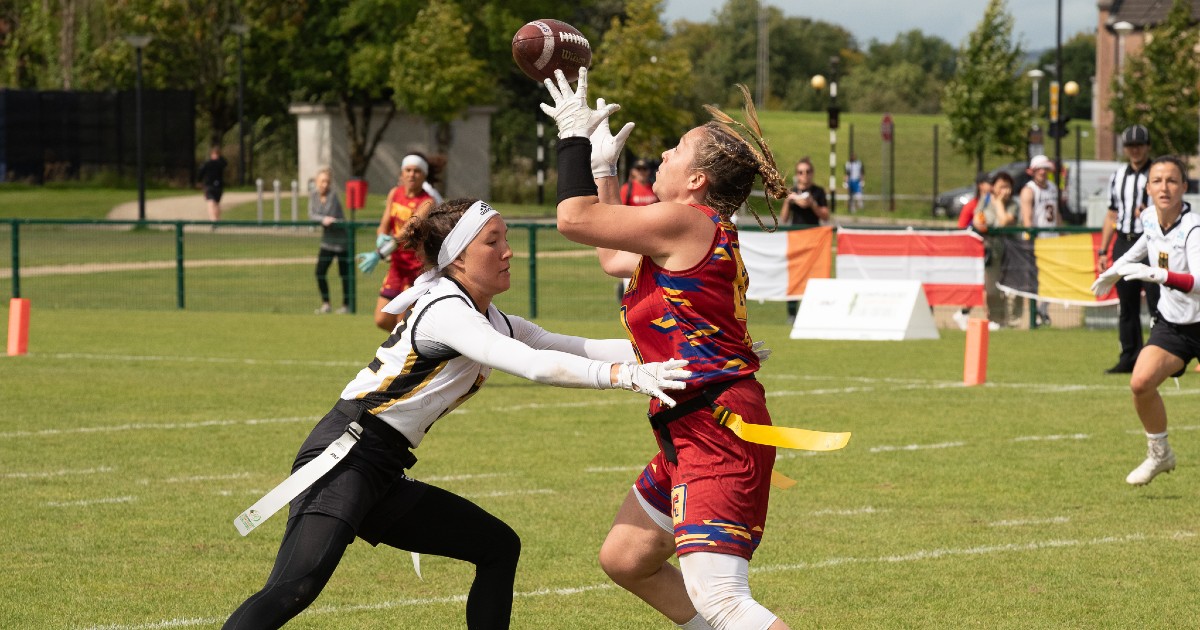Pioneering study can improve injury prevention in flag football ahead of Olympic debut
A Stirling-led study could have a major impact on one of the world's fastest growing sports
/filters:format(webp)/filters:no_upscale()/prod01/cdn/media/stirling/news/news-centre/2025/jul-25/1200X630FlagFootball.jpg)
A first-of-its-kind University of Stirling-led study into one of the world’s fastest growing sports could help to prevent injuries ahead of its first Olympic appearance.
Flag football will debut at the 2028 Olympic Games in Los Angeles, with National Football League (NFL) figures estimating that 20 million people around the world now play the sport – and a record 31 nations competing in last year's Flag Football World Championships.
Considered the most inclusive and accessible form of American football, flag is a fast, non-contact version of the game where, instead of tackling, defenders must pull a flag from the waist of the attacking player who has the ball.
Now, new research, published in Frontiers in Nutrition, is the first to present detailed body measurement data outlining the typical build, muscle mass and body fat of elite flag football players – offering a greater understanding of the physical demands they face.
It is hoped that the findings will be used to design better training and nutrition programmes, inform injury prevention strategies, and improve talent identification systems as the sport moves towards its Olympic debut.
 An international team worked on the first-of-its-kind Stirling-led Study.
An international team worked on the first-of-its-kind Stirling-led Study.
The study found that male athletes had greater muscle and bone mass, body mass and stature, while female athletes had higher skinfold values and a greater percentage of adipose tissue – indicating higher body fat levels.
Most players showed a mesomorphic body type, meaning a muscular profile. This allowed the research team to develop reference values and performance indicators for both sexes that can now be used by coaches, sport scientists and nutrition professionals.
Significant findings
A team from Scotland, England and Mexico, led by Dr Nidia Rodriguez-Sanchez from the University of Stirling’s Faculty of Health Sciences and Sport, worked in close collaboration with the International Federation of American Football (IFAF) to study athletes during the 2023 European Flag Football Championships.
Dr Rodriguez-Sanchez, who was joined by Stirling colleague Dr Lewis Macgregor on the project, said: “These references are valuable for training, injury prevention and performance monitoring. They also support evidence-based practice in sports nutrition by helping practitioners better understand the physical demands and body composition needs of athletes in this sport.
“We believe that these findings will become even more important as flag football moves into the Olympic context, as a way to guide training, nutrition and inform injury prevention strategies.”
Despite soaring popularity, there are currently no standard references for the physical characteristics of elite players, making it difficult to ensure that training, nutrition and injury prevention are as effective as possible.
Athlete welfare
The study has been welcomed by the International Federation of American Football (IFAF), the international governing body for the sport of American football, which is responsible for all regulatory, competition, performance and development aspects of the game on a global level.
IFAF Managing Director, Andy Fuller, said: “We welcome this research as an important resource for IFAF’s member federations and all those operating high-performance programmes in flag football around the world. Athlete welfare and development are at the heart of our responsibilities as an International Federation.”
The research was supported by IFAF, which provided access to competition facilities, coordination with team coaches, and assistance during the European Championships.
Andy Fuller added: “IFAF was pleased to facilitate this study as part of a broader proactive approach to identifying and implementing best practices in injury prevention, recognising the demands of flag football’s accelerated worldwide growth.”
Researchers analysed 139 players from 13 countries, with anthropometrists – specialists in the measurements and proportions of the human body – measuring the skinfolds, girths, lengths, breadths, stature and body mass of competing athletes.
 Researchers studied athletes during the 2023 European Flag Football Championships
Researchers studied athletes during the 2023 European Flag Football Championships
The study, Is there a need for anthropometric standards in Olympic sports? A proposal for the kinanthropometric profile of elite flag football athletes, followed the International Society for the Advancement of Kinanthropometry (ISAK) protocol, which is the global standard for anthropometric assessment in sport.
Use of the method allowed the team and practitioners to collect high-quality data that can be compared across sports and populations, allowing a greater understanding of how body composition can inform evidence-based advice given to athletes.
It brought together 11 researchers with expertise in kinanthropometry, physiology, nutrition, physiotherapy, sports medicine, and sport science.
As well as Dr Rodriguez-Sanchez, it involved experts from the University of Alicante, Leeds Beckett University, and Mexican institutions the Autonomous University of Chihuahua, the Iberoamericana University, and Amerike University.
 Members of the research team: (l-r) Luis Gerardo Vazquez-Villarreal, MD; Claudia Maceroni; Eleanor Travis; Dr Nidia Rodrigez-Sanchez; Martha Patricia Dergal-Irigoyen, MD; Dr Luis Felipe Talavera-Hernández; Dr Lewis James Macgregor
Members of the research team: (l-r) Luis Gerardo Vazquez-Villarreal, MD; Claudia Maceroni; Eleanor Travis; Dr Nidia Rodrigez-Sanchez; Martha Patricia Dergal-Irigoyen, MD; Dr Luis Felipe Talavera-Hernández; Dr Lewis James Macgregor
